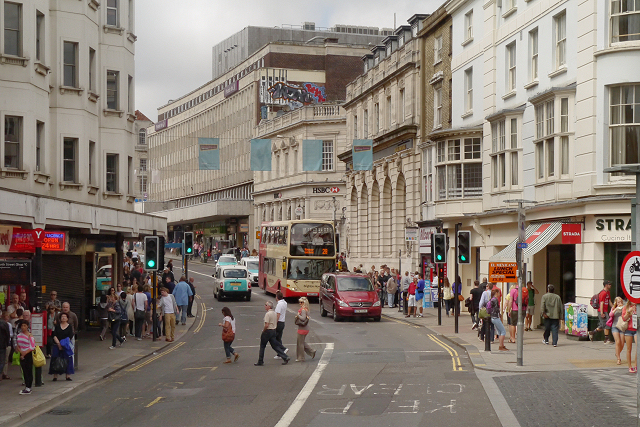Brighton’s North Street has been named the seventh worst street for air pollution in the country outside London.
Friends of the Earth, an international network of environmental organisations, recently published the ten worst sites across England (outside London) for breaching the annual Air Quality Objective for Nitrogen Dioxide (NO2), revealing North Street Clock Tower to be at number seven. Neville Street in Leeds topped the list.
Air pollution is widely recognised as the UK’s largest environmental risk to public health, causing health issues such as lung cancer and heart and respiratory diseases. Nitrogen Oxide, and similar gas Nitric Oxide, are also capable of producing dangerous weather such as Smog and Acid Rain.
Chris Todd from Brighton and Hove Friends of the Earth (BHFoE) told The Badger “We need to be taking steps to tackle this as soon as possible, not just in North Street but everywhere. For many pollutants there are no known safe levels so we need to act to reduce emissions across the whole city”
When asked whose fault the high pollution levels were, Mr Todd said “Everyone’s. National government has been denial about this problem for decades and still failing to act decisively.
“Local government could also do more but doesn’t, particularly around promoting alternatives to car use. We’re luckier here in Brighton than some areas, but still change is painfully slow.”
A spokesperson for Brighton and Hove City Council (BHCC), however, stated that “Through the Air Quality Programme Board, we are working with partners including Brighton & Hove Buses, to lead on a joined up approach to improving air quality throughout the city.
“We have already taken steps to tackle air pollution, including investing in low emission public transport, developing electric vehicle infrastructure and improving pedestrian and cycle links.
“Air quality is also a consideration in the planning process with recommendations for cleaner technologies to reduce emissions across the city.”
The University of Sussex Climate Action Movement society (CAM) also spoke to The Badger about these findings. They said,
“It makes these areas a threat to the health of the people in Brighton.
“Many of the roads in Brighton exceed EU and UK standards of air pollutant level, specifically the levels of NO2.
“This makes areas of central Brighton less appealing to travel by foot or cycling, because breathing the air in these areas is unpleasant and causes serious harm to human health.”
When asked who they thought was to blame for the high levels of pollution, they said “I think it ultimately comes down to inadequate monitoring and funding.
“In March last year Defra rejected a bid from Brighton and Hove Council and the Brighton Bus company for funds to fit buses with technology to reduce the pollutants being released into the air.
“Because the monitoring only happens in one area, an area that is not representative of the levels of air pollution in many areas of the city Defra did not see the reason for further funding of air pollution prevention measures.
“Despite Brighton and Hove council having flagged the problematic placement of the air pollution measuring equipment.”
Public transport is often seen as a major cause of air pollution, however domestic transport is the sector responsible for the highest greenhouse gas emissions in the UK, accounting for 28% of the total emissions in 2016, says the independent Committee on Climate Change.
The Committee’s Reducing UK Emissions 2018 Progress Report says buses make up only 1% of the UK’s total GHG, while cars make up 15% of the UK’s total GHG emissions; lorries 4%; vans 4% and other transport, including mopeds, motorbikes, shipping and domestic flights, account for a further 2%.
There has been much praise of Brighton’s bus companies’ commitments to lowering emissions.
Mr Todd stated “Both The Big Lemon and Brighton & Hove Buses have invested heavily in cleaner buses and that should be recognised. Even their diesel buses are often cleaner than diesel cars a fact most people don’t realise.”
CAM also stressed support for B&H Buses use of alternative technologies to reduce emissions, “but again this would require much more funding than is currently available to them.”
In January, Brighton and Hove Buses was awarded the ISO 50001, an International Standards Organisation accreditation which sets the standard of excellence for energy management. The company spent £7.76 million last year on 31 almost emissions-free Euro 6 standard buses and is on target to operate a zero emissions fleet by 2030.
Brighton and Hove Buses said “We continue to invest millions every year in cleaner vehicles to ensure we’ve met LEZ standards, while working in partnership with the council to improve air quality in the city.”
They also said that the Euro 6 standard buses “have significantly more efficient engines and translate into seismic reductions in NO2 emissions“ and will begin regularly operating in the North Street and Clock Tower area from August 2019.
There has been widespread desire for a change in the North Street Clock Tower area. BHCC stated that the Clock Tower has the highest pedestrian movements in the city and are looking to improve Queens Road and West Street in the ‘Gateway to the Sea’ project.
Mr Todd also told The Badger “we need to remodel the Clock Tower junction so that buses can travel both ways at the same time for longer periods so they are not waiting in queues unnecessarily creating pollution.
“To do this we also need to restrict private vehicles down Queens Road and West Street.
“There is no need for them to go this way and the relatively small number that do, hold up thousands of bus users everyday.”
He also stressed that more action was needed on delivery vehicles within the city, suggesting the use of electric vehicles.
CAM proposed creating areas in the town centre just for pedestrians and cyclists.
They said “Many of the roads in Brighton do not have cycle paths, and even the ones that do require cyclists to be confident navigating traffic on the roads.
“This in combination with adequate monitoring of the air quality in more areas, to then inform funding decisions.”
Image credit: Geograph: David Dixon


